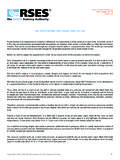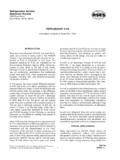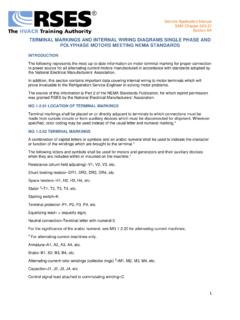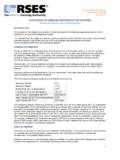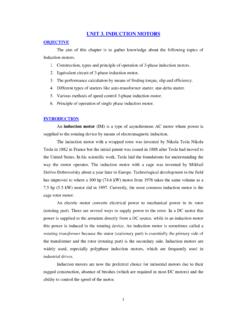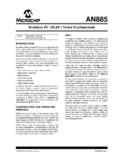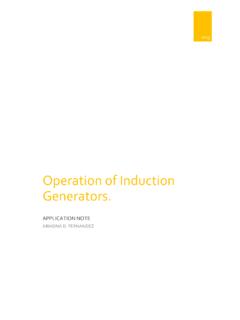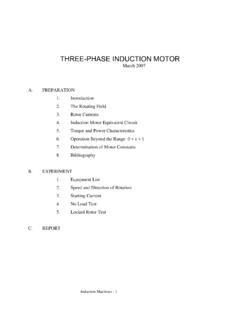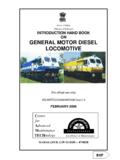Transcription of ELECTRONICALLY COMMUTATED MOTORS Part 1: History …
1 OVERVIEW OF ECM TECHNOLOGYE lectronically COMMUTATED motor (ECM) technologyhas been in use for over 20 years in the HVACR industry. Predominantly used in variable-speedindoor blower MOTORS , ECMs were introduced in 1987 by GE (rebranded Genteq in 2009). Theseinnovative MOTORS provide improved efficiency, aswell as programming and comfort options not possiblewith PSC induction MOTORS . However, they are stillwidely misunderstood, misapplied, and is ECM technology? ECM technology is basedon a brushless dc (direct current) permanent magnetdesign that is inherently more efficient than the ac(alternating current) shaded-pole and permanentsplit-capacitor (PSC) MOTORS commonly found in airhandlers, furnaces, heat pumps, air conditioners, andrefrigeration applications throughout the HVACR industry.
2 By combining electronic controls withbrushless dc MOTORS , ECMs can maintain efficiencyacross a wide range of operating speeds. Plus, theelectronic controls make the ECM programmable,allowing for advanced characteristics that areimpossible to create using conventional motortechnologies. The information that follows pertains to direct-drive indoor blower MOTORS and outdoor fanmotors built in 1 5-, 1 3-, 1 2-, 3 4-, and 1-hp MOTORS are used in residential and lightcommercial HVAC systems of 5 tons or the mid 1900s, alternating current (induction) PSCmotors became the standard for fractional-horsepowermotors used in residential and light commercialHVAC systems for both indoor and outdoor (split-system and package) units.
3 The PSC motor (built withrun and start windings and an external run capacitor)is more efficient and provides better starting torquethan its predecessor, the shaded-pole motor (builtwith a run winding and shading coils). The physicaldesign of these MOTORS makes them simple and easyto operate, but also limits their operational range andefficiency. The operational range is limited by thenumber of speeds or speed taps, the number of polesin the stator, and the frequency of the deliveredpower (which is typically 60 Hz in the ). Thepoles of the motor as constructed cannot be changed,and the delivered frequency is fixed by the utilitycompany, which means that the only adjustments that can be made to the output of the motor are thespeeds.
4 These are essentially adjustments to thehorsepower by tapping the winding at the speed is selected, the output is also greatlyaffected by the resistance of the air-side components,the dirt load, the duct sizing, and the registers andgrilles. Some of these resistances are fixed, whileothers change over the life of the system. Due to air-side resistance and the fixed design of the motor , thebottom line is that once a speed has been selected forthe HVAC system demand, the amount of airflow thatthe motor can produce cannot be the top of the next page is a chart that shows thelimitations of PSC indoor blower MOTORS (which aretypically 6-pole MOTORS ) and outdoor fan MOTORS (typically 8-pole MOTORS ).
5 Synchronous speedisfrequency (Hz) multiplied by 120 divided by thenumber of poles. PSC MOTORS do not run atsynchronous speed due to slip (electrical andmechanical losses in the motor and external load).1 ELECTRONICALLY COMMUTATED MOTORSPart 1: History and Overview of ECMsby Christopher MohalleyGenteq Certified Master ECM Trainer 2010 by the Refrigeration Service Engineers Society, Des Plaines, ILSupplement to the Refrigeration Service Engineers Application ManualSAM Chapter 650-003 Section 6A Therated speed(data plate rating) is the actualoperating speed of the motor at one test point(typically high speed) under a given load. Theoperational rangeof the motor refers to how fast orslow the motor is capable of operating due to loadand speed typical maximum efficiency of a multispeed PSCmotor is around 60% at its design rated speed andload.
6 This efficiency may decrease further, dependingon load and operating speed. A large factor in PSCmotor efficiency is rotor loss. In PSC MOTORS , themagnetic field (north and south poles) of the rotor is created by an inductive magnetic force from thestator. This magnetic force comes from power appliedto the stator MOTORS basically have twocomponents the rotating section, orrotor, surrounded by the stationarysection, or stator(see Figure 1).The stator does not move, butthe magnetic force in thestator does, creating arotating (north andsouth) magneticeffect. The rotor,with an inducednorth and southfield, simply followsthe rotating fieldcreated in the ECM can bedescribed simply as a basic electricmotor, operated by a microprocessor-based motor of line voltage being provided directly to the winding (speed taps) to energize the motor (as in PSC and shaded-pole MOTORS ), line-voltagepower is supplied continuously to the motor operate the motor , a separate communicationsignal is sent to the motor control specific to theHVAC system airflow requirement for each demand(heat, cool, fan, etc.)
7 This communication, inconjunction with the unique programming in themotor control, allows the microprocessor to operatethe motor at a very specific and controlled speed,torque, or combination of the two to create therequired airflow. These controls greatly increase the range of operation, as well as the efficiency over that operating range. They also provide moreprecise control, and allow the operation of the motorto be adjusted internally to compensate for air-siderestrictions that cannot be controlled by PSC HVAC literature listed these MOTORS as ICMs (integrated control modules), meaning that a controlwas integratedor used in conjunction with a motor to control its operation.
8 The terminology was laterchanged to ECM ( ELECTRONICALLY commutatedmotor), as they are typically referred to today. Thedefinition of commutateis to change or reverse thePSC MOTORSF ixed frequency(60 Hz )6 poles8 polesSynchronous speed(60 Hz)1200 rpm900 rpmRated speed(data plate)1075 rpm825 rpmOperational range900 1100 rpm600 850 rpm2 SleevebearingStator(stationary part)Rotor(rotating part)ShaftEndshieldEndshieldFigure 1. Typical ac induction electric motorCOURTESY OF GENTEQ direction of an electric current (the means by whichall electric MOTORS rotate). In an ECM, this process iscontrolled ELECTRONICALLY by a microprocessor andelectronic controls, which provide the ability toincrease or decrease the speed of the type of ECM currently used by most residentialHVAC systems is a brushless dc three-phase motorwith a permanent magnet rotor.
9 motor phases aresequentially energized by the electronic control,powered from a single-phase supply. An ECM isactually made of two components a motor control(thecontrol module) and a motor (sometimes calledthemotor module). Depending on the style of ECM,the motor control may be a separate component apartfrom the motor or it may be integrated into the motorshell (see Figure 2).Themotor controlserves as the brains of thedevice, where single-phase (1 ) 120-, 240-, 277-, or 460-V ac 60-Hz power is connected. Input voltageis determined by each model. Some models operateat a single discrete voltage, while others are capableof dual voltages. The control then converts ac powerto dc power to operate the internal electronics (thusthe description of an ECM as a dc motor ).
10 Themicroprocessor in the motor control is programmed to convert dc power (by means of electronic controls)to a three-phase (3 ) signal to drive the motor (thusits description as a three-phase motor ). Themicroprocessor also has the ability to adjust thefrequency (which controls the speed in revolutionsper minute) and the level of current (torque or power)that it delivers to the motor . The operation of themotor is determined by the programming in themicroprocessor and the communication inputs it receives from the HVAC system controls. Thecommunication may be in the form of ac or dcvoltage, PWM (pulse width modulation, or dutycycle), or DSI (digital serial interface) from theHVAC system controls to determine the level atwhich to operate the motor for the desired airflow by demand (heat, cool, fan, etc.)
